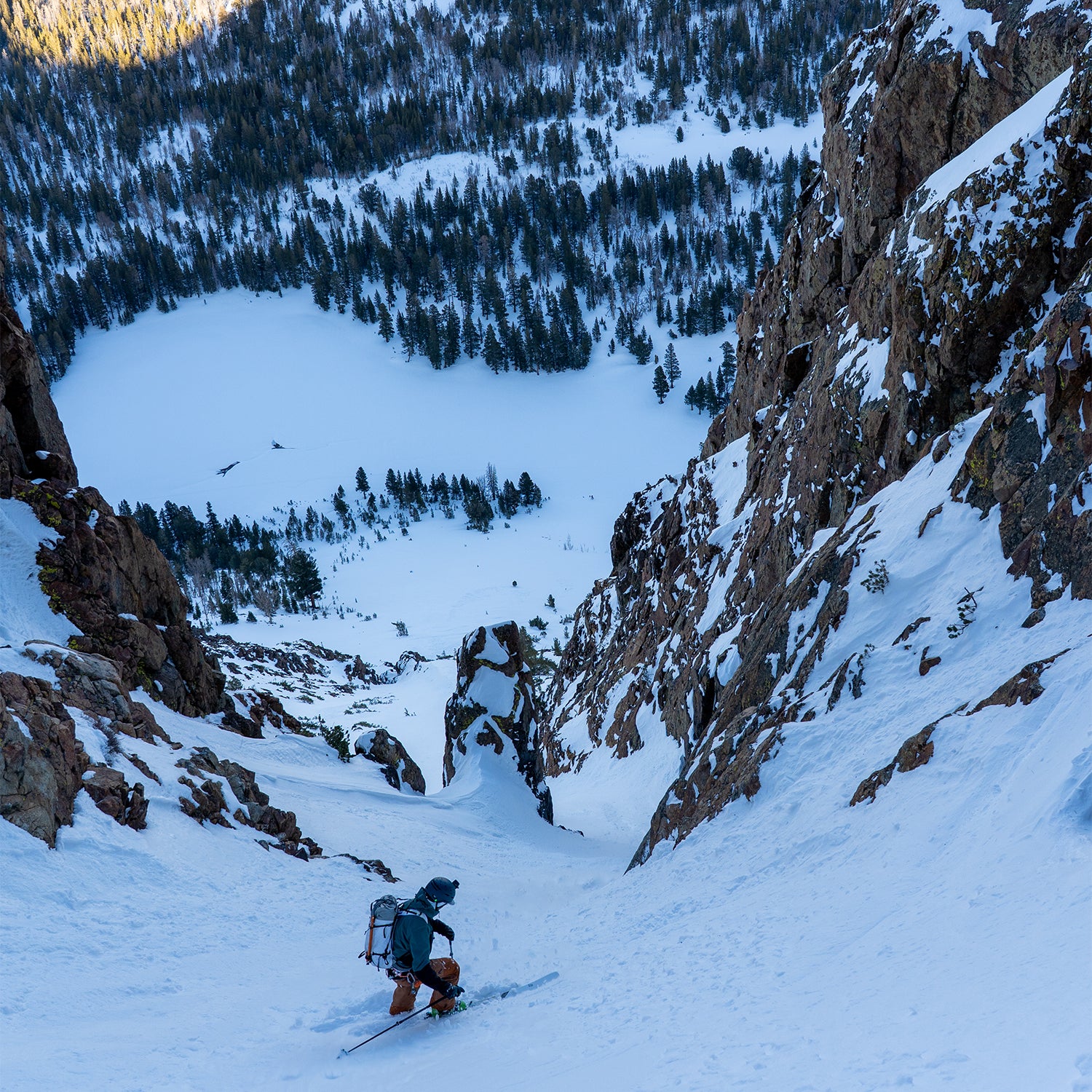The sun had set by the time I reached the top of the skin track on Earthquake Dome, a popular backcountry skiing zone near my home in Mammoth Lakes, California, and I hadn’t packed a headlamp. It was a February evening and I’d driven ten minutes from my home in town to ski an after-work lap. I’d overestimated my speed and underestimated the low winter sun, and now I was transitioning a pair of uniquely shaped skis—so rockered they looked like a banana—for their first ever lap downhill. I couldn’t see a thing and just prayed I wouldn’t slip and take a pratfall like in a cartoon.
A few weeks earlier I sat on a Zoom call with Xan Marshland, the co-founder of WNDR Alpine. Marshland had wanted me to test the Intention 108, the Salt Lake City-based brand’s flagship ski made partially with stringers of an algae-derived plastic. Very few ski manufacturers put polyurethane (i.e. plastic) in skis right now, typically opting for combinations of wood, fiberglass, carbon fiber, and aluminum alloys. But polyurethane is an engineered material, meaning ski makers can tune its stiffness, rebound, and vibration damping properties to make the ski do exactly what they want. And only WNDR’s plastic is fully renewable. Marshland believes that not only does the algae make WNDR’s skis eco-friendlier, but it also makes them perform better. “In the mountains, materials matter,” he told me.
I’ve tested skis for a living for the last five years, and I have long been skeptical of space-age and eco-friendly materials being responsible for marked increases in performance. But as I’ve spent more and more time on the WNDR Intention 108, it has turned into my favorite ski ever made.
Unfortunately, the future of WNDR Alpine is unknown at this time. The company recently put all of their skis and snowboards on clearance and seem to have sold the entirety of their backstock. Marshland told me that the brand has some prospective buyers in the wings, but did not offer specifics. It seems that, without a fresh infusion of cash, WNDR Alpine may fold entirely. I, for one, hope the brand finds a new home and continues to be a driving force of innovation and sustainability in skiing.
How Does WNDR’s Algae-Based Plastic Affect Ski Performance?
Standing atop Earthquake Dome that night and clicking into the skis, it was time for the algae-based plastic to hit the snow. (People say that, right?) I let my headlamp-equipped fiancée lead, figuring I could follow her light through the maze of tight trees back to the car. I followed, skiing by the faint, quickly-receding glow of white—my only guide. After getting used to the ample rocker (e.g. after a few tumbles in the dark) I began to increase my speed and feel what Marshland had described on our call in the ski’s construction. The Intention 108 was remarkably damp, the polyurethane in its core muting the vibrations that should have been transmitted to my body from the firm and choppy snow that had been sitting for a few weeks since the last storm.
As I began to ski the WNDR Intention 108 more and more in the coming weeks, I realized that the plastic was the secret sauce—that it was sustainably sourced was just icing on the cake. Think of it like a ski boot. Heavier ski boots designed for expert skiers, and ski racers in particular, are made from a heavy polyurethane that is formulated to produce a smooth, progressive flex when a skier drives their shins into it. That flex then rebounds, popping a skier into their next turn. This ski had the exact same feeling—the dampness, the stability, and, when pushed, the return of energy that drew me across the fall line.
Why I Love Skiing the WNDR Intention 108
Since that first tour, I’ve been skiing the WNDR Intention 108 whenever I can. Though I mounted them with a lightweight pin binding for backcountry skiing, I often ski them at the resort when the snow is soft. I’ve traveled with the Intention 108 to Canada for my bachelor party at RED Mountain Resort, I’ve skied waist-deep powder, bulletproof wind-crusted snow, and even rappelled with them into a 55-degree couloir with dubious sun-crusted ice. With its substantial weight, I could see putting a hybrid binding like the or ATK Hy Free on it and skiing it both in and out of bounds.
I’ve skied many hundreds of different pairs of skis in my life, but the Intention 108 is hands-down my favorite. I trust it high in the mountains, deep in the backcountry, and in a variety of snow conditions. I ski more bad snow than good, and these skis are not just dependable—they’re so much fun.
You can tame the loose, unlocked feel of the Intention 108’s full rocker shape by putting the ski on edge, or fully embrace it by skiing it on a flat base. In steep terrain with firm snow—the conditions many experts will tell you necessitate having camber under your feet—the Intention 108 can pivot and slide, making it easy to hop turn down sketchy stuff. The full rocker profile also makes the Intention 108 is easy to ski in moguls and air off the slightest bump or takeoff. It even carves surprisingly well for its width and lack of traditional camber. I’ve never ridden a ski that possessed such mind-boggling versatility.
An obvious sticking point for a lot of skiers will be the Intention 108’s weight. In a 188 centimeter length, this ski weighs 2,000 grams. That’s a lot for most skiers to lug uphill, but WNDR doesn’t bill the Intention 108 as a dedicated backcountry ski. If your average day in the mountains has you clocking more than 3,000 to 4,000 feet of elevation gain, you may want to consider a lighter ski.
But for me, with a lightweight tech binding (a ) and a medium-weight AT boot (the ), I find that I don’t start to drag below 4,000 vertical feet. Even on huge days in the backcountry, the ski’s weight can be advantageous—on long tours in the high alpine you often encounter all sorts of weird and difficult snow textures; the Intention’s weight can help mellow out rough conditions.
I wish more ski manufacturers would consider putting polyurethane in their products. Regardless of the sustainability, which is awesome, they’re just more predictable than twitchy, carbon-filled backcountry skis, or even solid-wood core alpine skis. WNDR’s algae-based plastics and resins replace toxic glues and petroleum products in their skis, leading to a ski that’s both easier to recycle and less harmful if it ever does end up in a landfill.
Granted, skiers who prioritize edge hold in nasty snow will want to opt for a cambered ski. Those skiers are in luck: the Intention 108 also comes in a cambered shape.
Making Skis More Sustainably
WNDR made a move last year to make their Intention 108 in the Sideways Sports (SWS) factory in Dubai. The idea was to bring their algae oil technology, developed by WNDR’s parent company, Checkerspot, to a facility that also makes snowboards for Arbor, Jones, and Liquid Force. Once the factory knows how to use the microalgae-oil plastic, they can use it in other brands’ products.
I have mixed feelings about this.
On the one hand, making their product in a facility that uses 100-percent green energy is a huge win. And I’m hugely supportive of the sharing of ideas that could make the snowsports industry less harmful to the environment. The SWS factory also has the capability to produce a binding plate made from the factory’s own reclaimed waste that is 35 percent stronger than the industry standard. That means fewer bindings rip out of skis, and fewer skis end up in the dumpster.
That said, making skis in Dubai—far away from the snowsports world—vastly increases product shipping distances, requiring more fuel and energy. Dubai also has a suspect history with labor rights and safety standards that shouldn’t be overlooked. My greenwashing (and ) antennae tend to prick up when I hear of sustainability and the United Arab Emirates, but I leave that for the reader to parse.
That said, I am certain that WNDR Alpine is good for the ski industry. Though its future is uncertain, I hope the company finds a competent buyer and continues to push skiing forward. In the meantime, you can find me high in the alpine through the summer months with the Intention 108 under my feet.


